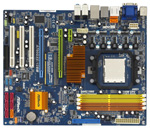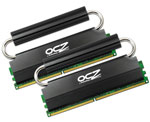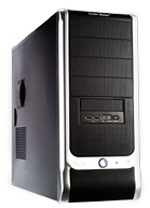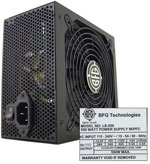Phenom II Budget
Our aim in the Phenom II budget system is to provide a configuration that allows for a nice balance of performance at stock speeds. This doesn't mean you have to spend a lot of money though, as Phenom II prices start at $120 now that the competitive dust has settled. In addition, other component prices have dropped in the past six months and performance for the dollar has definitely increased.
The budget build is around $750 complete with a 1080p LCD Monitor, speakers, Vista Home Premium OS (OEM), and a mouse and keyboard. The basic box is just over $400 with a case and Gold Editors' Choice 550W PSU. If you are pinching pennies, you can go with a name brand case/power supply combo and get the basic Phenom II box below $400. The assembled system is balanced for a wide variety of computing tasks, but final tweaks can tilt it toward gaming and graphics for example, if that is what you aim for.
Generally we consider PC gaming rigs to begin at the next price category (i.e. the low end of midrange), but adding a decent graphics card will definitely make the Phenom II budget system, built around the AMD Phenom II X3 710, a good choice for entry gaming at around $850. Just add the $100 Radeon 4850 from the value systems on the next page.
| AMD Phenom II Budget PC | ||
| Hardware | Component | Price |
| Processor | AMD Phenom II X3 710 (2.6GHz x3, 3x512KB L2, 6MB L3 Cache) |
$119 |
| Cooling | CPU Retail HSF | - |
| Video | On-Board | - |
| Motherboard | ASRock A790GXH/128M AM2+ | $95 |
| Memory | OCZ Reaper 4GB DDR2-1066 OCZ2F10664GK ($61 with $25 rebate) | $36 |
| Hard Drive | Seagate Barracuda 7200.12 ST3500418AS 7200RPM 16MB Cache 500GB | $60 |
| Optical Drive | Samsung 22X DVDRW/DL SH-S202G | $25 |
| Audio | On-Board | - |
| Case | Cooler Master Elite 330 RC-330-KKN1-GP Mid Tower | $40 |
| Power Supply | BFG Tech LS Series LS-550 550W SLI Certified, CrossFire Ready, 80 PLUS Certified (After $20 Rebate) | $60 |
| Base System Total | $435 | |
| Display | ViewSonic VX2233wm Black 21.5" 5ms Widescreen 16:9 LCD (1920x1080) | $180 |
| Speakers | Logitech S-220 17W RMS 2.1 Multimedia Speaker | $24 |
| Input | Microsoft CA9-00001 Black PS/2 Standard Keyboard and Optical USB/PS2 Mouse - OEM | $17 |
| Operating System | Microsoft Vista Home Premium OEM | $99 |
| Complete System Bottom Line | $755 | |
The Phenom II x3 710 is the least expensive Phenom II you can buy, but it is still a tri-core design clocked at 2.6GHz with the same L1/L2/L3 cache as the more expensive Phenom II designs. The 710 provides plenty of power at stock speeds, but if you want more the 45nm Phenom II processors overclock very well. If you want a bit more performance, overclocking the 710 should be fine, but if you want to seriously explore overclocking you can spend $20 more for the 720BE that has an unlocked multiplier.
 |
We've paired the Phenom II 710 with the ASRock 790GXH/128M AM2+, a perfect match for those looking to squeeze as much performance out of their money as possible. The ASRock is loaded with overclocking features and includes integrated AMD HD 3300 graphics with an HDMI/DVI interface and 1080p support. This means very decent performance using the onboard graphics. This ASRock board offers both AM2+ and AM3 CPU support for processors like the Phenom II 710 when used with cheaper DDR2 memory. ASRock includes 128MB DDR2 sideport memory for improved GPU performance, VIA VT1708S 7.1 Audio codec, Gigabit LAN, 16GB memory support, six 3Gb/s SATA ports capable of RAID 0/1/10/5, a PATA port, 10 USB ports, two PCI-E x16 slots (dual x8 CF), one PCI-E x1 slots, and two PCI slots. The BIOS caters to the casual overclocker and this board performs very well in a variety of tests.
 |
We've chosen OCZ Reaper 4GB DDR2 1066 (PC2 8500) in a 4GB kit for just $36 after a $25 rebate. This is a great value in DDR2-1066 memory from a top memory supplier. The extra 1066 speed combined with the fast 5-5-5 timings lets you run your memory at a faster speed or provide reserves for overclocking the CPU. OCZ is a great memory choice, but there are many memory options at great prices today. Quality DDR2-800 and DDR2-1066 RAM from Corsair, OCZ, G.Skill, Mushkin, Patriot, and GeIL are available at any of the major online retailers. Just be sure to look for RAM with better timings if you can afford it.
 |
The hard drive is a 500GB Seagate Barracuda at just $59. If you'd prefer a larger drive you can substitute a 1TB Seagate for just $85 - only $25 more for twice the capacity. The DVD burner is a dependable Samsung 22X often chosen for budget builds. If you want alternatives, as always you can look to the other builds for larger drives and Blu-ray support.
 |
 |
The case/PS is the Cooler Master Elite 330 and our AnandTech Gold Editors' Choice BFG Tech LS Series LS-550 550W power supply. The BFG currently has a $20 rebate that reduces the final cost to $60. The BFG is a great power supply, but you could save a few dollars here with an OCZ, Corsair, or PC Power & Cooling PSU, which are often on rebate in recent months. It all depends on the timing of your system purchase.
 |
The LCD display was an easy choice with the full HD Viewsonic 16:9 widescreen for just $180. A 21.5" monitor with 1920x1080 resolution with a 3-year warranty from a major monitor maker is certainly a good value. If you prefer a larger screen, you can find a 23" widescreen starting at $190, though most 24" are $250 or more. If you need to save a few dollars a lower resolution 19" or 20" would do.
 |
If you want more video power for gaming you can add an ATI HD 4830 for just $75-$90. This will get you into gaming and it is a terrific value at this price according to our Graphics Editor. He recommends the Radeon HD 4850 as the start of true HD gaming starting at just $100 after current rebates, or a Radeon HD 4870 512MB which you can find for as little as $155. Any of these three cards would still keep your total well below $1000. Even with the addition of the powerful 4870 512MB the complete system price would be just $910.










60 Comments
View All Comments
Gary Key - Monday, April 27, 2009 - link
I have not noticed poor SATA performance on the SB750. It is typically a few percent lower than the ICH10R in actual applications, but nothing that you ever notice on a day to day basis. As far as ACHI/NCQ problems, I have not experienced them with the SB710/750 yet.This includes Linux and Windows installations. I know people have complained about it, but I just have not seen it yet in probably 300+ installs of either operating system. The one problem I have right now is SSD performance is not up to par to the ICH10. AMD is working on a new driver to improve performance as the hardware is fine.
Wesley Fink - Monday, April 27, 2009 - link
Early AMD southbridges did suffer from the issues you describe. The design and performance has steadily improved with each new generation of southbridge, and AMD has come a long way from the SB400/450 days. I have forwarded your question to our motherboard Editor for more info on the state of the SB750 southbrudge.lefenzy - Friday, April 24, 2009 - link
Would Anandtech please stop recommending 1080P monitors? LCD manufacturers are tricking consumers by selling screens with less area with this marketing gimmick.JarredWalton - Friday, April 24, 2009 - link
I don't see how it's a "trick", since the resolution is clearly stated. If you want to complain about it being "less monitor", I'd be far more upset about all the TN panels now being pushed into budget displays. I've used/tested several, and they're "fine" for most users, but they will never be the quality of an S-PVA, S-MVA, or S-IPS LCD.Honestly, if you want a good IPS display at a reasonable cost, what I'd really recommend these days is to grab a 32" HDTV - check it out in person though to make sure it's not a TN panel, because those are showing up as well. Just look at the vertical viewing angles and it should be clear whether it's TN or not.
MadMan007 - Saturday, April 25, 2009 - link
Can't fit a 32" TV on my desk nor sit ~3 feet away from it comfortably :p I wrote about the monitors as well. I will say that 1920x1080 is a win over 1680x1050 IF they are similar prices or a bit more and same panel types, at least you're getting more for the money. ex: a 1920x1080 TN for $50 more than a 1680x1050 TN. It's a ripoff when they substitute less vertical space in the same supposed screen size (the diagonal measurement allows them to cheat there) for the same price.Where this article fails is in not even mentioning panel types nor aspect ratios, and using a freaking TN in a $1600 system.
These guides are starting to read more like advertising copy when they push fudged specs rather than informing readers.
lopri - Friday, April 24, 2009 - link
Thank you for this wonderful guide. It's been a while since I planned to build a Phenom system, and it looks like I can finally finish it thanks to this guide. I do have a couple of questions.1. There are many DDR3 sticks marketed as 'i7 edition'. Is it safe to use those sticks on AM3 platform? (both compatibility and overclocking-wise)
2. What is the system requirement of AOD (AMD OverDrive)? Does it work only on a board with SB750 or..?
I am very excited to get a 955BE. Tired of vTT, vFSB, vGTL, vWTFU1Di0t... on Intel quads.. I'd like to play with multipliers, dividers, and timings instead!
Wesley Fink - Saturday, April 25, 2009 - link
Question 2 - From AMD:"This is release V3.0.1 of AMD OverDrive™ Utility.
This version of AMD OverDrive™ Utility supports systems with the AMD RD890/RD790/RS780/RX780/RS780D/RS880 serials boards.
AMD OverDrive™ Utility in general is designed to provide users the ability to maximize the capability, flexibility, and adjustability of the AMD chipset products; it allows user to tune parameters to help system stability, optimize performance, and control cooling/acoustic characteristics. AMD’s target is to provide an all-in-one utility which can deliver all-around stellar operation.
---System Requirements---
Operating systems supported are:
Microsoft® Windows Vista® 32-bit
Microsoft® Windows Vista® 64-bit
Microsoft Windows® XP
Microsoft Windows XP Professional x64 Edition
Microsoft Windows 7"
lopri - Sunday, April 26, 2009 - link
Thank you much, kind sir!Wesley Fink - Friday, April 24, 2009 - link
Question 1 - The Core i7 memory controller is on the CPU, and it and the motherboard design is the controlling factor for triple-channel, dual-channel, and single-channel memory. The DDR3 memory itself is essentially the same whether used as single, dual, or triple-channel memory. Things are best when matched modules are used for memory.Since the Phenom II AM3 supports Dual-channel DDR3 and not triple-channel you are better off buying dual-channel DDR3 kits mainly because if you install 3 dimms your system will run in single channel mode, and if in dual channel you have an extra dimm. However, we have used triple channel dimm kits for Core i7 in AM3 dual-channel setups with no problems. One builder I know buys only triple-channel for the best value and then uses 2 or 3 or 4 or 6 DDR3 dimms - whatever is needed and works on the system - in his builds.
The other way around is more an issue though, as the Core i7 memory controller can be very picky about the DDR3 you feed it. We know plenty of dual-channel dimms - mostly pre i7 - that work fine on other DDR3 boards, but that do not always play well with Core i7.
Question 2 - We are trying to find an answer to this one.
PrinceGaz - Friday, April 24, 2009 - link
You don't seem to mention anything about the network adapter in these systems. I know the motherboards all have built-in ethernet socket(s), but for gaming would you recommend a Killer Xeno Pro (or even the upcoming Killer Xeno Ultra)?